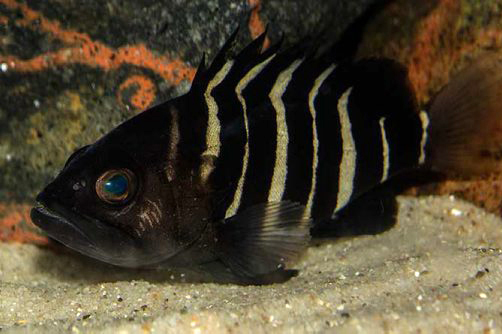- Classification
- ACTINOPTERYGII
- PERCIFORMES
- SERRANIDAE
- Hyporthodus
- ergastularius
Banded Rockcod, Hyporthodus ergastularius (Whitley 1930)
Other Names: Barcod, Down-under Grouper, Grey Banded Cod, Grey-banded Rock-cod, Rockcod, Sevenbar Grouper

A juvenile Banded Rockcod, Hyporthodus ergastularius, in Nelson Bay, Port Stephens, March 2014 - depth 7 m. Source: Dave Harasti / http://www.daveharasti.com/. License: All rights reserved
Summary:
A pinkish-grey to greyish-brown grouper with darker fins with white margins, and with or without dark bars on the body.
Juveniles are pale brownish to dark brown, with narrow white bars alternating in thickness along the body. The anterior bars extend onto the dorsal fin, and the last bar is on the caudal-fin base. Juveniles also have a prominent black streak just above the upper jaw.
This species was previously placed in the genus Epinephelus.
Juveniles are pale brownish to dark brown, with narrow white bars alternating in thickness along the body. The anterior bars extend onto the dorsal fin, and the last bar is on the caudal-fin base. Juveniles also have a prominent black streak just above the upper jaw.
This species was previously placed in the genus Epinephelus.
Cite this page as:
Bray, D.J. 2018, Hyporthodus ergastularius in Fishes of Australia, accessed 19 Apr 2024, https://fishesofaustralia.net.au/home/species/3853
Banded Rockcod, Hyporthodus ergastularius (Whitley 1930)
More Info
|
Distribution |
An Australian endemic known from off Dunk Island, QLD, south to about Eden, NSW; also in the Lord Howe Island region and on the Norfolk Ridge in the Tasman Sea. Adults mostly inhabit deep reefs, while juveniles may occur in shallower waters. |
|
Features |
Dorsal fin XI, 14-15; Anal fin III, 9-10. Body depth 2.6-2.9 times in SL; head length 2.4-2.6 times in SL; slightly convex interorbital area and dorsal head profile; subangular preopercle, finely serrate, serrae on rounded corner not enlarged and ventral edge with 1-4 small serrae; almost straight upper edge of operculum; posterior nostrils 2-4 times larger than anterior nostrils; maxilla reaching almost to vertical at rear edge of eye; 2 rows of small teeth on midlateral part of lower jaw |
|
Feeding |
Carnivore - feeds on fishes, crustaceans and molluscs. A juvenile was taken on hook and line in Sydney Harbour using squid as bait. |
|
Biology |
A protogynous hermaphrodite. Females are thought to mature at between 70 and 80 cm in length and 6 to 8 kg in weight. |
|
Fisheries |
Fished commercially in deep waters in the New South Wales Ocean Trap and Line Fishery, mostly on vertical droplines. The species is also caught on deep reefs in Queensland. |
|
Remarks |
Hyporthodus ergastularius may be a complex of several cryptic species. |
|
Species Citation |
Epinephelus (Schistorus) ergastularius Whitley 1930, Aust. Zool. 6(2): 119, pl. 14(fig. 1). Type locality: off Long Bay, near Sydney, New South Wales, Australia. |
|
Author |
Bray, D.J. 2018 |
|
Resources |
Banded Rockcod, Hyporthodus ergastularius (Whitley 1930)
References
Craig, M.T. & Hastings, P.A. 2007. A molecular phylogeny of the groupers of the subfamily Epinephelinae (Serranidae) with a revised classification of the Epinephelini. Ichthyological Research 54(1): 1-17.
Craig, M., YJ.S. de Mitcheson & P.C. Heemstra. 2011. Groupers of the world: a field and market guide. North America: CRC Press/Taylor and Francis Group. 356 pp. (as Hyporthodus ergastularius)
Griffin, L.T. 1926. Descriptions of New Zealand fishes. Transactions and Proceedings of the New Zealand Institute 56: 538-546.
Heemstra, P.C. & Randall, J.E. 1993. Groupers of the World (Family Serranidae, Subfamily Epinephelinae). An annotated and illustrated catalogue of grouper, rockcod, hind, coral grouper and lyretail species known to date. FAO Fisheries Synopsis No. 125 Vol. 16. Rome: FAO. pp. 1-382 (as Epinephelus ergastularius)
Heemstra, P.C. & Randall, J.E. 1999. Family Serranidae. pp. 2442-2548 in Carpenter, K.E. & Niem, T.H. (eds). The Living Marine Resources of the Western Central Pacific. FAO Species Identification Guide for Fisheries Purposes. Rome : FAO Vol. 4 pp. 2069-2790. (as Epinephelus ergastularius)
Pollard, D. & Rhodes, K. 2008. Hyporthodus ergastularius. The IUCN Red List of Threatened Species. Version 2014.3.







